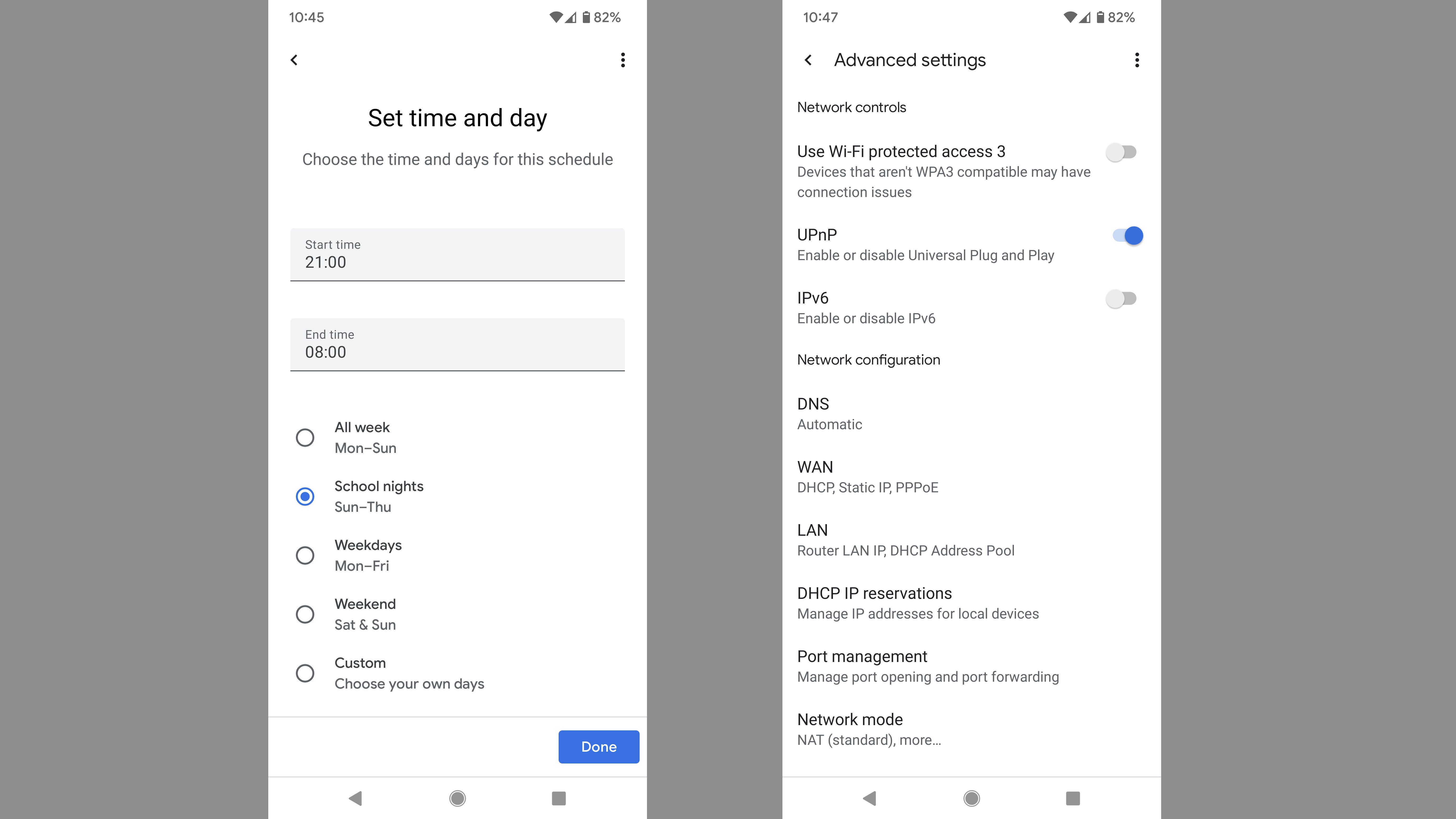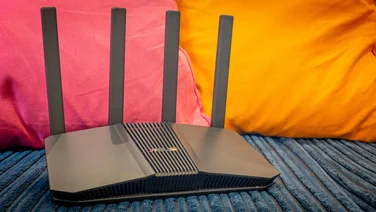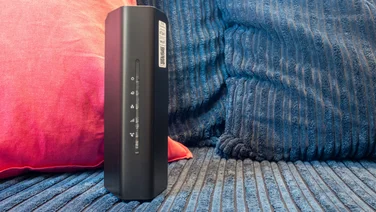To help us provide you with free impartial advice, we may earn a commission if you buy through links on our site. Learn more





- Easy setup with the Google Home app
- Disappointing download speeds
- Limited physical connectivity
- Short on advanced features
It’s been three years since Google launched the Nest Wifi home mesh system, and an update is long overdue. While new phones and devices have universally moved up to the latest Wi-Fi 6 and 6E technologies, Google’s last mesh is stuck on the ageing Wi-Fi 5 standard.
The new Nest Wifi Pro brings the platform up to date, with full support for Wi-Fi 6E. At the same time, something’s been taken away: last-generation Nest Wifi nodes had built-in audio hardware, enabling them to perform double duty as smart speakers. That’s gone now, meaning the Nest Wifi Pro only does Wi-Fi.
That’s not the biggest problem with the Nest Wifi Pro, however. This may be Google’s fastest ever Nest Wifi system, but – as you’ll see below – we found it still can’t keep up with rival mesh solutions. If you want the fastest Wi-Fi speeds you’ll have to look elsewhere.
Google Nest Wifi Pro review: What you need to know
You can buy the Nest Wifi Pro as a standalone router or in a pack of three identical stations. Google claims that one Nest Wifi Pro unit can cover an area of up to 120m², while running three together extends that up to 320m². As always, take those figures with a pinch of salt, as they can’t account for the particular layout or dimensions of your home.
Google doesn’t make any detailed promises about the speeds of the Nest Wifi Pro system, but it advertises a maximum combined throughput of 4.2Gbits/sec across its 2.4GHz, 5GHz and 6GHz radios. There’s no dedicated backhaul radio, so if you’re running in mesh mode then some of that bandwidth will be eaten up by traffic forwarding between stations.
Each Nest Wifi Pro unit also has two Ethernet sockets. That’s an improvement on the 2019 model, which only had sockets on the router unit, but the ports still only support gigabit speeds. That’s a shame, as 2.5GbE is becoming increasingly common, allowing you to get the best possible speeds between wired and wireless clients.
READ NEXT: Maximise your speeds with our favourite Wi-Fi 6 routers
Google Nest Wifi Pro review: Price and competition
A single Nest Wifi Pro unit costs £190, so if you’re looking for a standalone Wi-Fi 6E router, it’s the cheapest option we’ve seen. The closest alternative is the Netgear RAXE300, but at £350 it’s not really within the same price bracket.
Most people, however, will surely be looking at the three-unit pack at £380. That’s only twice the cost of a single station, so it looks like decent value. It’s not much more expensive than the £350 TP-Link Deco XE75 pack, which only comes with two mesh units.

Aside from that, the only other 6E-enabled mesh we’ve reviewed is the flagship Netgear Orbi RBKE963; at £1,500 we doubt that’s at the top of many people’s shopping lists.
There are plenty of alternatives that use regular Wi-Fi 6, but the best ones aren’t much cheaper than 6E. The Linksys Atlas Pro 6 (£380) costs the same as the Google Nest Wifi Pro for a three-node kit, while the TP-Link Deco X90 is considerably more expensive at £449 for two stations – although it does benefit from 2.5Gbits/sec Ethernet, as well as a dedicated backhaul radio.
Cheaper options include the Netgear Orbi RBK352, costing just £150 for two stations, while the Huawei Mesh 3 provides three units for £250. These systems aren’t as fast as the best Wi-Fi 6E meshes, but they should provide the coverage you need for everyday work and video streaming.
Google Nest Wifi Pro review: Design and features
With their shiny, rounded design, the Nest Wifi Pro units look a bit like outsized Pixel Bud cases. They’re bigger, obviously, but not enormous: each one stands 130mm tall, with a footprint that extends to maximum dimensions of 117 x 85mm. At the front, a single white LED glows and pulses to reflect the state of your network, while at the back you’ll find your two Gigabit Ethernet ports and a tasteful indented Google logo.

There’s nothing else to see, unless you turn the thing upside-down. On the base there’s a reset button plus a QR code, which you can scan in the Google Home app to instantly connect and start setting up your network. It’s impressively quick and easy.


All subsequent administration is also carried out through the app: if you type the IP address of the Nest Wifi Pro router into a browser, it just brings up download links for the app, plus a link to Google’s online help pages. This probably makes more sense than offering two separate management interfaces, as most routers and meshes do. Sadly, I don’t find the Wi-Fi section of the Home app at all intuitive – it’s a mess of buttons, text links, panes, arrows, cogwheel icons and “kebab” menus.It does give you the essential controls for a home network. You’ll find options for IP address reservation and port forwarding, and the ability to nominate particular clients for QoS priority. You can enable a guest network too, and allow or deny guest access to individual clients on the main network – a nice touch. For those with kids, the Family Safety option lets you set per-device schedules and block adult content using Google’s SafeSearch database. This is rather a blunt instrument, but it’s nice to have the capability included in the price.There are several things you can’t do on the Nest, however. For one, you can’t split your network into three different SSIDs: the router presents a single network name, and decides for itself whether to connect you on the 2.4GHz, 5GHz or 6GHz frequencies.
The Nest Wifi Pro also has no native network security functions, no support for VPN connections (either inbound or outbound), no dynamic DNS support and no failover option for internet outages. Since the units don’t have USB sockets, you can also forget about sharing storage or serving up media.
Google Nest Wifi Pro review: Performance
Google hasn’t published full Wi-Fi specifications for the Nest Wifi Pro, but I found my test laptop (equipped with an Intel AX210 Wi-Fi 6E card) was able to connect on the 6GHz band at 2.4Gbits/sec, while the 5GHz network topped out at 1.2Gbits/sec.
Those speeds aren’t wholly encouraging. The very fastest mesh systems connect at up to 4.8Gbits/sec on both the 5GHz and 6GHz bands. What’s more, the Nest Wifi Pro units are unusually compact – meaning that they obviously don’t have enormous antennas inside.
To find out what this means for performance, I tested the three-node system in my usual way. I started by installing the main unit in my study, connecting one of its Ethernet ports to a Virgin Media fibre broadband line and the other to an Asustor Drivestor 4 Pro NAS appliance. I installed the second unit at the far end of the bedroom, next to the study. The third station went downstairs in the living room.
Then, I took my test laptop to various points around my home, copied a standard set of 100MB files to the NAS, and measured the transfer speeds. I did this first over the 6GHz network; here are the speeds I saw, compared to the other two Wi-Fi 6E meshes we’ve tested:


The Nest Wifi Pro gave me a solid wireless connection even in the farthest reaches of my home. The minimum download speed I saw was 23.2MB/sec, which isn’t far off the full speed of a 200Mbits/sec fibre internet line. For same-room connections, the connection was so fast that I suspect the bottleneck was the Gigabit Ethernet connection, rather than the Wi-Fi link.
Even so, there’s no getting around the fact that the cheaper TP-Link Deco XE75 gave me much better overall download rates – with only two stations. Ordinarily, I would have tried tweaking the Nest’s wireless settings to see if I could finagle any additional performance out of it. Unfortunately, this is impossible with Google, as the Home app doesn’t give you any visibility into wireless frequencies, channel width or transmission power.
I then repeated the test while connected on the 5GHz band, to see how the Nest Wifi Pro network worked for non-6E clients. Alas, even against much cheaper Wi-Fi 6 meshes, the Google system struggled to keep up:


Compared to meshes of all types and price points, the Nest Wifi Pro’s performance was at best equivocal. In three of my five test locations I got faster downloads from the £150 Orbi RBK352 than from Google’s system.
The Nest did turn in an unexpectedly strong performance in the living room – here, only the barnstorming Deco X90 provided higher download speeds. But with a mesh you want whole-home consistency, not odd pockets of performance. Power consumption is nothing special, either: each Nest Wifi Pro unit idled at around 11.2W, peaking at 13.6W during my tests.
READ NEXT: The best mesh Wi-Fi routers available
Google Nest Wifi Pro review: Verdict
The Nest Wifi Pro is capable of delivering far more bandwidth than most people need. All through my three-bedroom house it provided a strong network connection, fast enough to stream 4K video, participate in video calls, share big files and generally live the connected life to the full.
The trouble is, I could say the same thing about multiple mesh systems costing half the price. And if you’re willing to pay for a network that goes above and beyond everyday performance, the TP-Link Deco XE75 is a much more compelling choice – and it’s still cheaper.
The Nest Wifi Pro doesn’t win many points for versatility or user-friendliness either: even though the feature set is quite sparse, the app manages to make things confusing. On paper, a three-node Wi-Fi 6E mesh for £380 looks like a great deal, but you’ll do better to spend your money almost anywhere else.







